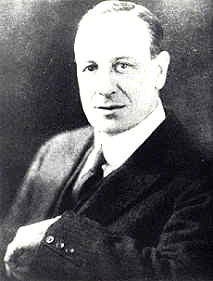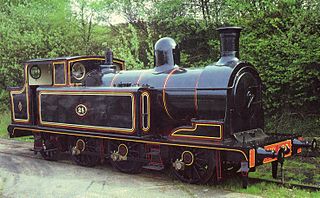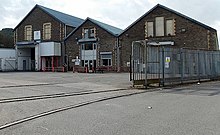
The North Tyneside Steam Railway and Stephenson Steam Railway are visitor attractions in North Shields, North East England. The museum and railway workshops share a building on Middle Engine Lane adjacent to the Silverlink Retail Park. The railway is a standard gauge line, running south for 2 miles (3.2 km) from the museum to Percy Main. The railway is operated by the North Tyneside Steam Railway Association (NTSRA). The museum is managed by Tyne and Wear Archives and Museums on behalf of North Tyneside Council.

The Derby Works comprised a number of British manufacturing facilities designing and building locomotives and rolling stock in Derby, England. The first of these was a group of three maintenance sheds opened around 1840 behind Derby station. This developed into a manufacturing facility called the Midland Railway Locomotive Works, known locally as "the loco" and in 1873 manufacturing was split into locomotive and rolling stock manufacture, with rolling stock work transferred to a new facility, Derby Carriage & Wagon Works.

Novelty was an early steam locomotive built by John Ericsson and John Braithwaite to take part in the Rainhill Trials in 1829.

The GWR 5600 Class is a class of 0-6-2T steam locomotive built between 1924 and 1928. They were designed by Charles Collett for the Great Western Railway (GWR), and were introduced into traffic in 1924. After the 1923 grouping, Swindon inherited a large and variable collection of locomotives from historic Welsh railway companies, which did not fit into their standardisation programme. GWR boiler inspectors arrived en masse and either condemned the original locomotives or had them rebuilt. The systematic destruction of many examples of locomotives, most still in serviceable condition, followed, but various were worked alongside 5600 Class.

A motive power depot (MPD) or locomotive depot, or traction maintenance depot (TMD), is where locomotives are usually housed, repaired and maintained. They were originally known as "running sheds", "engine sheds" or just "sheds". Facilities are provided for refuelling and the replenishing of water, lubricating oil and grease and, for steam engines, the disposal of ash. There are often workshops for day-to-day repairs and maintenance, but locomotive building and major overhauls are usually carried out at locomotive works.

Ashford railway works was a major locomotive and wagon construction and repair workshop in Ashford, Kent in England. Constructed by the South Eastern Railway in 1847, it became a major centre for railway works in the 19th and early 20th centuries. After years of decline, it closed in 1982.
Wolverhampton railway works was in the city of Wolverhampton in the county of Staffordshire, England. It was almost due north of the city centre, and is commemorated with a small display of level crossing gates and a plaque. Known as the Stafford Road Works, it was opened by the Shrewsbury and Birmingham Railway in 1849 to maintain bought-in locomotives.

Swindon Works was opened by the Great Western Railway in 1843 in Swindon, Wiltshire, England. It served as the principal west England maintenance centre until closed in 1986.

Eastleigh Works is a locomotive, carriage and wagon building and repair facility in the town of Eastleigh, in the county of Hampshire in England.

Brighton railway works was one of the earliest railway-owned locomotive repair works, founded in 1840 by the London and Brighton Railway in Brighton, England, and thus pre-dating the more famous railway works at Crewe, Doncaster and Swindon. The works grew steadily between 1841 and 1900 but efficient operation was always hampered by the restricted site, and there were several plans to close it and move the facility elsewhere. Nevertheless, between 1852 and 1957 more than 1200 steam locomotives as well as prototype diesel electric and electric locomotives were constructed there, before the eventual closure of the facility in 1962.

Charles Benjamin Collett was Chief Mechanical Engineer of the Great Western Railway from 1922 to 1941. He designed the GWR's 4-6-0 Castle and King Class express passenger locomotives.

Stratford Works was the locomotive-building works of the Great Eastern Railway situated at Stratford, London, England. The original site of the works was located in the 'V' between the Great Eastern Main Line and the Stratford to Lea Bridge route and in the early years was also the home of Stratford Locomotive Depot. The final part of the works closed in 1991.

The Taff Vale Railway A class was a class of 0-6-2T steam tank locomotives designed by J. Cameron for mixed traffic work and introduced to the Taff Vale Railway (TVR) in 1914. The A class was an enlarged version of the TVR O4 class designed by Tom Hurry Riches in 1907. The A class was the last new class of locomotive to be introduced on the TVR, which had introduced its first 0-6-2Ts in 1885 ; and, with a total of 58 built, was numerically the largest class of tank locomotive on the TVR.

Gorton Locomotive Works, known locally as Gorton Tank, was in West Gorton in Manchester, England and was completed in 1848 by the Sheffield, Ashton-under-Lyne and Manchester Railway.
Bow railway works was at Bow, an area of London, England, in the London Borough of Tower Hamlets. It was built in 1853 by the North London Railway.

The Taff Vale Railway (TVR) O1 class is a class consisting of fourteen 0-6-2T steam tank locomotives, designed by Tom Hurry Riches, which were introduced to the TVR during the period 1894-1897.
Cathays railways works was a railway engineering development by the Taff Vale Railway to provide its main carriage and wagon works, as well as its main railway depot for the entire TVR system, located in the Cathays suburb of Cardiff, South Wales.

A steam railcar is a rail vehicle that does not require a locomotive as it contains its own steam engine. The first steam railcar was an experimental unit designed and built in 1847 by James Samuel and William Bridges Adams. In 1848, they made the Fairfield steam carriage that they sold to the Bristol and Exeter Railway, who used it for two years on a branch line.

West Yard Works was the Taff Vale Railway's locomotive repair and construction factory. It was located in Cardiff between Bute Street and the Glamorganshire Canal, about 100 metres west of Bute Dock railway station.

The NZASM 19 Tonner 0-4-2T of 1891 was a South African steam locomotive from the pre-Union era in Transvaal.

















